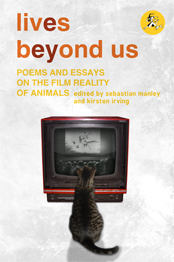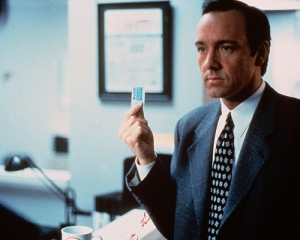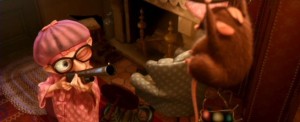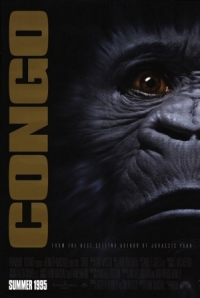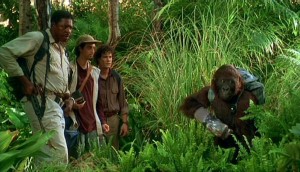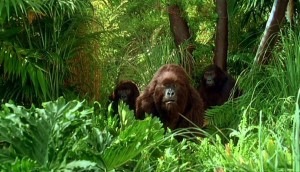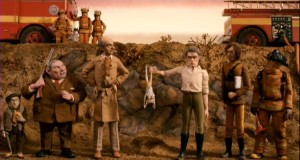
It may not surprise anyone to find that a film about the inner workings of the fast food industry contains some uncomfortable truths and some disturbing images, and Fast Food Nation (Richard Linklater, 2006) delivers a high number of both. I don’t know if the film has turned anyone vegetarian, but I am fairly sure that I finished watching the final scene – in which we are presented with images of cows being slaughtered and dismembered – looking like Jimmy as he exits the cattle slaughterhouse in the ‘Meat and You: Partners in Freedom’ infomercial in The Simpsons (Jimmy doesn’t turn vegetarian in the end, having been convinced by Troy McClure of the natural moral authority of the food chain and of cowkind’s latent disregard for human life).
To the disappointment of the Guardian’s reviewer (Peter Bradshaw; see here), though not of others (e.g. A. O. Scott in the New York Times), scenes such as this offering a direct, documentary-style exposé of the horrors of the meat industry are quite infrequent. The film does work into its narrative a considerable number of worrying details about the industry and its practices, drawn from the bestselling non-fiction book Fast Food Nation by Eric Schlosser (also the film’s co-writer). Near the start of the film, for example, we learn that a McDonald’s-type fast food corporation called Mickey’s has been knowingly selling burgers containing a significant amount of faecal matter – a revelation that the film’s main character, Mickey’s executive Don Anderson (Greg Kinnear), initially has trouble processing. Other details concerning the ill treatment of meatpacking plant workers and the industry’s various deceptions emerge as Don investigates the burger production process. But such details, in a way familiar from the vast majority of ‘issue’-oriented fiction film (1), constitute just one thread running through a story of emotional dramas and aspirations: one character dreams of leaving behind her life in a dead-end town, another struggles to maintain a good relationship with her sister under difficult circumstances, and so on. As Linklater himself puts it, ‘Characters take you beyond the politics. You can watch a movie and like it without necessarily agreeing with what the director is saying.’ (2)
Should a critic of the fast food industry and its treatment of animals (or its attitude towards the environment or the safety of its consumers) feel as confident as Bradshaw in saying that Linklater – himself a vegetarian since his twenties, having been influenced by Peter Singer’s seminal book Animal Liberation – is here guilty of obscuring the issues and trading in truth for earnest sentiment? I’m not sure. My feeling is that a factual examination of a particular issue, whether it is a book or a documentary, probably does have more of a chance of directly changing someone’s perspective. But there are truths that are more easily or more effectively explored in narrative fiction, and it may be that these truths have as much as a bearing on a political reality as do more familiar types of facts about practices, policies, and so on. Among Fast Food Nation’s disturbing truths I would count several about human behaviour, one being the failure of even good people to speak out against immoral activity, even (or especially) if this activity is being carried out on a large scale. Don is a thoroughly nice guy who, in the end, cannot bring himself to sacrifice his career and his family’s stability to do something about the iniquities of the Mickey’s corporation. For Bradshaw, Don is an expression of the movie’s ‘defeatism’, but I would suggest that the character instead offers a note of complexity which brings into question simplistic and probably limiting oppositions between the good people of the world and the bad (for an outline of why it might be a good idea for activists and others to reject ‘saints and sinners’ thinking, see Peter Singer on the tactics of the animal rights activist Henry Spira, here (item five)).
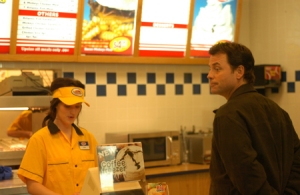 Don and Amber cross paths at Mickey’s
Don and Amber cross paths at Mickey’s
The difficulties and costs involved in following one’s conscience are also emphasised in another plotline, in which Amber (Ashley Johnson), a bright college student and Mickey’s employee, becomes increasingly uncomfortable with her participation in a system that she knows to be morally dubious. In one brilliantly played scene set at a party, Amber is drawn to a group of young activists who have been talking about corporate exploitation. After listening to them speak for a few minutes, she is called away by her best friend, who wants her to come and meet some guys she has been talking to. Amber, wanting to stay with the activists, declines. Her friend is baffled; ‘They’re so boring,’ she protests. They exchange a few more awkward words before finally parting ways, Amber clearly pained to see her idealism alienate her from her friend. Later scenes involving Amber address the issue of ethical action – particularly relating to animal welfare – more directly, but I’m glad Linklater and Schlosser were able to make a film where low-key observations about human nature form part of the picture.
Notes
1. For a good discussion of the treatment of social and political issues in US independent cinema (with which Linklater is often associated), see chapter 5 of Geoff King’s American Independent Cinema (London: I. B. Tauris, 2005).
2. See Xan Brooks, ‘I’ve Never Been in the Firing Line Like This Before’, The Guardian, 22 May 2006: www.guardian.co.uk/news/2006/may/22/food.film.
Works referenced
Bradshaw, Peter, ‘Fast Food Nation’, The Guardian, 4 May 2007.
Schlosser, Eric, Fast Food Nation: The Dark Side of the All-American Meal (New York: Houghton Mifflin Company, 2001).
Scott, A. O., ‘The Ties That Bind America’s Food Chain’, New York Times, 17 November 2006.
Singer, Peter, Animal Liberation, second edition (London: Pimlico, 1995).
Singer, Peter, ‘Ten Ways to Make a Difference’, in Susan J. Armstrong and Richard G. Botzler, The Animal Ethics Reader, second edition (London; New York: Routledge, 2008), pp. 627–632.
